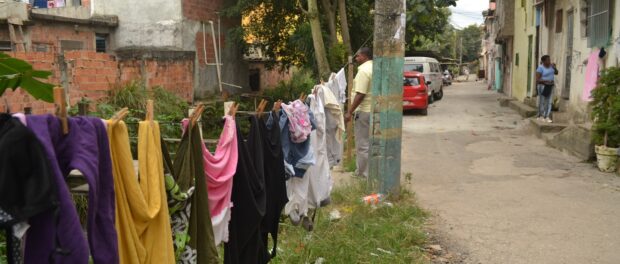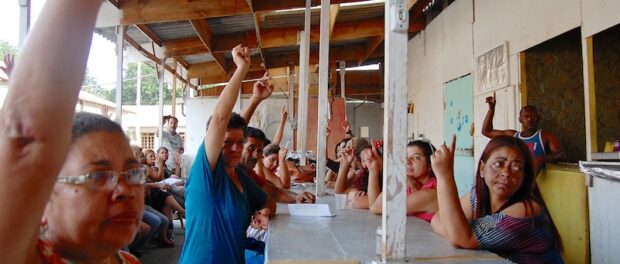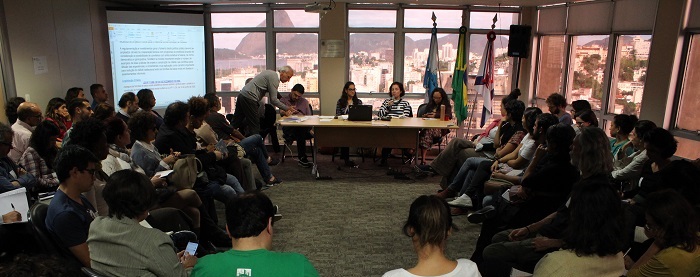
This is the second article in a four-part series on the potential to apply the Community Land Trust (CLT) model under existing Brazilian laws to secure land rights in Brazil’s favelas. The series was written for a Brazilian audience and summarizes and adapts a report by lawyer and urban planner Tarcyla Fidalgo, prepared with the support of the Lincoln Institute of Land Policy (LILP). It clarifies several aspects of the proposal, showing the foundations of the CLT model; adapting the model to favelas; and explaining its benefits, applicability, and ways of functioning. In this second part, we present a number of practical questions with regard to setting up a Community Land Trust in Brazilian favelas: how to start a CLT, the management of a CLT, the role of the State and land acquisition for the CLT, and how resale prices are determined on homes within a CLT.
The publication of this series follows five days of workshops (from August 23-27) with a delegation from Puerto Rico, whose members successfully implemented a CLT in eight informal settlements along the Caño Martín Peña in San Juan with excellent results. The workshops were carried out by Catalytic Communities* in partnership with the Rio de Janeiro State Public Defender’s Office, Pastoral de Favelas, the Architecture and Urbanism Council of Rio de Janeiro (CAU/RJ), and the Laboratory for Studies of Transformations in Brazilian Urban Law (LEDUB).
How to Start a Favela Community Land Trust
A Favela Community Land Trust (CLT) can begin from scratch or from an existing cooperative or other format, provided that its intention is to guarantee permanently affordable housing. To be viable, a CLT should take the form of an independent non-profit organization or association, therefore constituting a legal person. Questions concerning the creation of a legal person in order to form a CLT will be developed in the third part of this series, in which we will present the legal framework that makes the creation of this independent non-profit organization or association viable.
The first necessary condition to form a Favela Community Land Trust is the presence of a champion or group of champions within the community that want to create, implement and maintain a CLT in the neighborhood.
From there it’s important to have or generate broader, unified community support for this land ownership approach, and that this collective form of land management is in line with the community’s broader priorities.
- The existence of a reasonable prospect of land that can be included in the CLT—preferably without the CLT incurring debt—though there is no minimum amount or area of land required for its implementation;
- Contact with and the support of professionals in the areas of law, accounting, and urban development to advise on and support the implementation process, as well as maintenance and local development since managing the CLT presupposes a permanent and continuous program.
The above conditions are essential to the establishment of a Favela Community Land Trust. However, there are other conditions that also facilitate the implementation of a CLT.
On the list of additional conditions is support for the project, both on the part of other community organizations and authorities. It is possible to implement a CLT without the support of public authorities or existing local associations and organizations. However, having a solid base of support greatly facilitates implementation. As the proposal is to implement CLTs in existing favelas—and therefore in places where institutions, associations, and groups are already present—gaining the active or passive support of these groups through partnerships, for example, will contribute to the CLT’s development. With regard to public authorities, it is possible for a CLT to be implemented without official political support. This is one of the most favorable aspects of the model: it allows for self-organization without depending on specific legislation or any particular support from political institutions. However, municipal support does, in fact, configure the ideal and most favorable scenario since this support can result in tax exemptions, land donations, or funding and concessions to the CLT.
Another condition concerns the circumstances of the real estate market in the city. While it is possible to implement a CLT in different circumstances given fluctuations in the real estate market, times of intense real estate speculation or significant depreciation are less favorable. This is because it is more difficult for there to be interest on part of the residents during moments of significant land speculation (as occurred between 2011 and 2016 with the boom during the period of mega-events and Pacifying Police Units). Similarly, in periods of significant depreciation, there can be little interest among residents in remaining where they are. Therefore, the ideal scenario for implementation are times when neither of these extremes exists.
An addition condition relates to the conditions of existing properties in the area that will constitute the Community Land Trust. It is possible to create a CLT in diverse circumstances but the scenario is most favorable when buildings are in relatively good condition or could be adequately repaired to meet safety and habitability standards.
Finally, eventually there will be the need for an administrative team to operate the CLT. The CLT can be initiated with volunteers, but eventually, the ideal situation would be to maintain a paid team with operational support.
The Management of a Community Land Trust
It’s important to emphasize that all of the land included in the project is the property of the CLT, whereas existing buildings located on the land are individually-owned (capable of assuming other forms of ownership as well—such as cooperatives, for example, depending on residents’ interest). With regard to the management of land registered with a Community Land Trust, it is necessary to form an advisory board, which typically requires the participation of three different groups.
Voted on solely by members (i.e. resident-owners) of the CLT, a traditional CLT advisory board is comprised of thirds: (1) one-third residents of the CLT, (2) one-third technical advisors and representatives of support organizations and/or government, and (3) one-third residents of surrounding areas.
However, in considering the CLT model for favelas, it is necessary to adapt the board to local needs and circumstances. One suggested adaptation is to slightly alter the final third so that the board would be comprised of: (1) one-third resident-owners of the CLT, (2) one-third technical advisors, and (3) one-third other local people with direct interest in the objectives of the CLT in question (e.g., renters, merchants).
The Role of the State
If one is to consider supportive legislation to encourage the establishment of Favela CLTs, all three levels of government should be analyzed: federal, state, and local. However, the principal levels of government involved will be the federal government and municipalities, given that in the case of urban policy, the states are only delegated residual powers that are not enumerated in the Brazilian Constitution as responsibilities of the other two federative entities.
Municipalities have the authority to regulate urban policies and local interests, while various other legal instruments utilized in urban policies fall under the jurisdiction of the federal government (for example, the City Statute). In terms of tax systems, all three spheres of government are involved since federal, state, and municipal taxes can be levied. Political support from these spheres of government can coalesce, for example, to diminish taxes levied on CLT land, thus further facilitating economic accessibility.
Land Acquisition and the Value of Resold Properties
With regard to the acquisition of land to be included in the CLT, the transition should be formalized through means provided for in legislation and existing urban policy instruments. This process will be specified in the third part of this series, in which we will show the possibilities for transferring lands to the CLT through existing legislation and instruments. However, it is necessary to emphasize that once the land is transferred, it should never be resold—that is, the land is definitively removed from the real estate market. The land does not need to be designated as exclusively residential. Rather, it can be used for diverse purposes, from agriculture to commerce. This designation depends on local needs and thus decisions made by the CLT’s management.
In Brazil land acquisition for the CLT can occur in different ways, including purchase from a landowner, donation (of public land by government or private land by small individual title-holders), or land regularization. Purchasing the land is least recommended because it requires tremendous financial resources. With regard to the structures built on these lands, individuals receive surface rights which permit them to use, sell, inherit and take loans out on their buildings while still being part of the CLT. The process of newly acquiring a property within the CLT can take place in different ways, such as through sale or donation by the original owner. Normally, the new property owners receive a deed or contract that guarantees surface rights when the process is finalized.
As for property values, prices can either be regulated by the CLT or not. If the sale price is not predetermined, the fact that the land is not included in the property value already limits its future resale value as land value typically constitutes the largest portion of urban property values. Therefore, if residents chose to stipulate a resale value (normally based on the value of inflation, the value of the resident’s individual investments in the building, and other factors) at the time of forming the CLT, there will be a greater guarantee of maintaining affordability. In this case, the owners of buildings included in this system can carry out purchase and sale transactions, applying the calculated value. Still in other cases, the CLT itself is given first option to purchase homes and then resells them to qualified (i.e. low-income) families. The objective of establishing a given resale value is to both ensure that it is adequate compensation for residents who wish to sell their homes—taking into consideration their investments over the years—while maintaining affordability for future residents. Finally, it is necessary to reiterate that when a home is sold, the land on which it is situated continues to be part of the CLT, which can intervene as necessary to guarantee that the territory remains in good condition.
This is the second article in a four-part series.
*RioOnWatch is a project of the NGO Catalytic Communities


